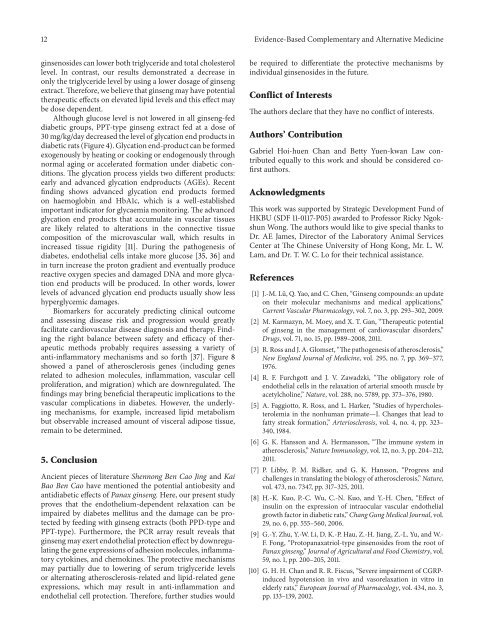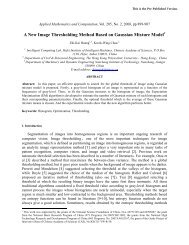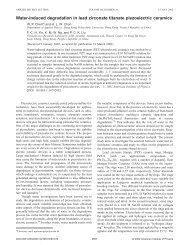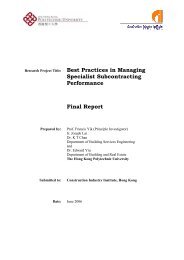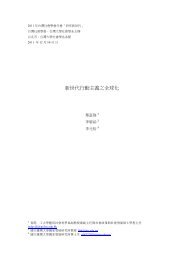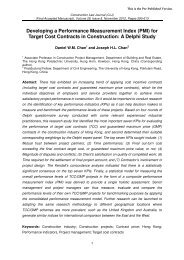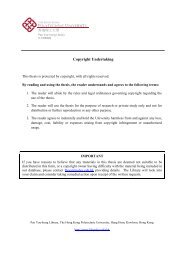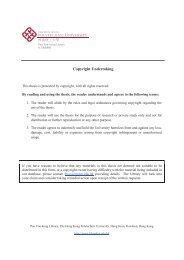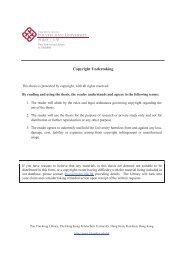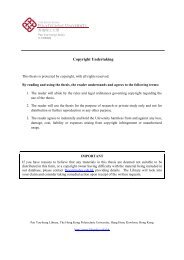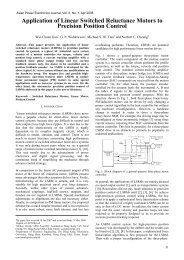Research Article Ginseng Extracts Restore High-Glucose Induced ...
Research Article Ginseng Extracts Restore High-Glucose Induced ...
Research Article Ginseng Extracts Restore High-Glucose Induced ...
Create successful ePaper yourself
Turn your PDF publications into a flip-book with our unique Google optimized e-Paper software.
12 Evidence-Based Complementary and Alternative Medicine<br />
ginsenosides can lower both triglyceride and total cholesterol<br />
level. In contrast, our results demonstrated a decrease in<br />
only the triglyceride level by using a lower dosage of ginseng<br />
extract. Therefore, we believe that ginseng may have potential<br />
therapeutic effects on elevated lipid levels and this effect may<br />
be dose dependent.<br />
Although glucose level is not lowered in all ginseng-fed<br />
diabetic groups, PPT-type ginseng extract fed at a dose of<br />
30 mg/kg/day decreased the level of glycation end products in<br />
diabetic rats (Figure 4).Glycationend-productcanbeformed<br />
exogenously by heating or cooking or endogenously through<br />
normal aging or accelerated formation under diabetic conditions.<br />
The glycation process yields two different products:<br />
early and advanced glycation endproducts (AGEs). Recent<br />
finding shows advanced glycation end products formed<br />
on haemoglobin and HbA1c, which is a well-established<br />
important indicator for glycaemia monitoring. The advanced<br />
glycation end products that accumulate in vascular tissues<br />
are likely related to alterations in the connective tissue<br />
composition of the microvascular wall, which results in<br />
increased tissue rigidity [11]. During the pathogenesis of<br />
diabetes, endothelial cells intake more glucose [35, 36] and<br />
in turn increase the proton gradient and eventually produce<br />
reactive oxygen species and damaged DNA and more glycation<br />
end products will be produced. In other words, lower<br />
levels of advanced glycation end products usually show less<br />
hyperglycemic damages.<br />
Biomarkers for accurately predicting clinical outcome<br />
and assessing disease risk and progression would greatly<br />
facilitate cardiovascular disease diagnosis and therapy. Finding<br />
the right balance between safety and efficacy of therapeutic<br />
methods probably requires assessing a variety of<br />
anti-inflammatory mechanisms and so forth [37]. Figure 8<br />
showed a panel of atherosclerosis genes (including genes<br />
related to adhesion molecules, inflammation, vascular cell<br />
proliferation, and migration) which are downregulated. The<br />
findings may bring beneficial therapeutic implications to the<br />
vascular complications in diabetes. However, the underlying<br />
mechanisms, for example, increased lipid metabolism<br />
but observable increased amount of visceral adipose tissue,<br />
remain to be determined.<br />
5. Conclusion<br />
Ancient pieces of literature Shennong Ben Cao Jing and Kai<br />
Bao Ben Cao have mentioned the potential antiobesity and<br />
antidiabetic effects of Panax ginseng. Here, our present study<br />
proves that the endothelium-dependent relaxation can be<br />
impaired by diabetes mellitus and the damage can be protected<br />
by feeding with ginseng extracts (both PPD-type and<br />
PPT-type). Furthermore, the PCR array result reveals that<br />
ginseng may exert endothelial protection effect by downregulating<br />
the gene expressions of adhesion molecules, inflammatory<br />
cytokines, and chemokines. The protective mechanisms<br />
may partially due to lowering of serum triglyceride levels<br />
or alternating atherosclerosis-related and lipid-related gene<br />
expressions, which may result in anti-inflammation and<br />
endothelial cell protection. Therefore, further studies would<br />
be required to differentiate the protective mechanisms by<br />
individual ginsenosides in the future.<br />
Conflict of Interests<br />
The authors declare that they have no conflict of interests.<br />
Authors’ Contribution<br />
Gabriel Hoi-huen Chan and Betty Yuen-kwan Law contributed<br />
equally to this work and should be considered cofirst<br />
authors.<br />
Acknowledgments<br />
This work was supported by Strategic Development Fund of<br />
HKBU (SDF 11-0117-P05) awarded to Professor Ricky NgokshunWong.Theauthorswouldliketogivespecialthanksto<br />
Dr. AE James, Director of the Laboratory Animal Services<br />
Center at The Chinese University of Hong Kong, Mr. L. W.<br />
Lam, and Dr. T. W. C. Lo for their technical assistance.<br />
References<br />
[1] J.-M. Lü, Q. Yao, and C. Chen, “<strong>Ginseng</strong> compounds: an update<br />
on their molecular mechanisms and medical applications,”<br />
Current Vascular Pharmacology,vol.7,no.3,pp.293–302,2009.<br />
[2] M. Karmazyn, M. Moey, and X. T. Gan, “Therapeutic potential<br />
of ginseng in the management of cardiovascular disorders,”<br />
Drugs, vol. 71, no. 15, pp. 1989–2008, 2011.<br />
[3] R. Ross and J. A. Glomset, “The pathogenesis of atherosclerosis,”<br />
New England Journal of Medicine, vol.295,no.7,pp.369–377,<br />
1976.<br />
[4]R.F.FurchgottandJ.V.Zawadzki,“Theobligatoryroleof<br />
endothelial cells in the relaxation of arterial smooth muscle by<br />
acetylcholine,” Nature, vol. 288, no. 5789, pp. 373–376, 1980.<br />
[5] A. Faggiotto, R. Ross, and L. Harker, “Studies of hypercholesterolemia<br />
in the nonhuman primate—I. Changes that lead to<br />
fatty streak formation,” Arteriosclerosis, vol.4,no.4,pp.323–<br />
340, 1984.<br />
[6] G. K. Hansson and A. Hermansson, “The immune system in<br />
atherosclerosis,” Nature Immunology,vol.12,no.3,pp.204–212,<br />
2011.<br />
[7]P.Libby,P.M.Ridker,andG.K.Hansson,“Progressand<br />
challenges in translating the biology of atherosclerosis,” Nature,<br />
vol. 473, no. 7347, pp. 317–325, 2011.<br />
[8] H.-K. Kuo, P.-C. Wu, C.-N. Kuo, and Y.-H. Chen, “Effect of<br />
insulin on the expression of intraocular vascular endothelial<br />
growth factor in diabetic rats,” Chang Gung Medical Journal,vol.<br />
29, no. 6, pp. 555–560, 2006.<br />
[9] G.-Y. Zhu, Y.-W. Li, D. K.-P. Hau, Z.-H. Jiang, Z.-L. Yu, and W.-<br />
F. Fong, “Protopanaxatriol-type ginsenosides from the root of<br />
Panax ginseng,” Journal of Agricultural and Food Chemistry,vol.<br />
59, no. 1, pp. 200–205, 2011.<br />
[10] G. H. H. Chan and R. R. Fiscus, “Severe impairment of CGRPinduced<br />
hypotension in vivo and vasorelaxation in vitro in<br />
elderly rats,” European Journal of Pharmacology,vol.434,no.3,<br />
pp.133–139,2002.


